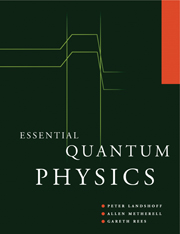Book contents
- Frontmatter
- Contents
- Preface
- Constants of quantum physics
- 1 Preliminaries
- 2 The Schrödinger equation
- 3 Special solutions
- 4 The superposition principle
- 5 The hydrogen atom
- Revision quiz
- 6 The hydrogen molecule
- 7 Introduction to perturbation theory
- 8 Spin
- 9 Masers and lasers
- 10 Band structure of crystals
- 11 Electron motion in crystals
- 12 Transistors
- Appendices
- Hints for the problems
- Index
1 - Preliminaries
Published online by Cambridge University Press: 05 June 2012
- Frontmatter
- Contents
- Preface
- Constants of quantum physics
- 1 Preliminaries
- 2 The Schrödinger equation
- 3 Special solutions
- 4 The superposition principle
- 5 The hydrogen atom
- Revision quiz
- 6 The hydrogen molecule
- 7 Introduction to perturbation theory
- 8 Spin
- 9 Masers and lasers
- 10 Band structure of crystals
- 11 Electron motion in crystals
- 12 Transistors
- Appendices
- Hints for the problems
- Index
Summary
Atoms
An atom consists of a positively charged nucleus, together with a number of negatively charged electrons. Inside the nucleus there are protons, each of which carries positive charge e, and neutrons, which have no charge. So the charge on the nucleus is Ze, where Z, the atomic number, is the number of protons. The charge on each electron is -e, so that when the atom has Z electrons it is electrically neutral. If some of the electrons are stripped off, the atom then has net positive charge; it has been ionised.
The electrons are held in the atom by the electrostatic attraction between each electron and the nucleus. There is also an attraction because of the gravitational force, but this is about 10-40 times less strong, and so may be neglected. The protons and neutrons are held together in the nucleus by a different type of force, the nuclear force. The nuclear force is much stronger than the electrical force, and its attraction more than counteracts the electrostatic repulsion between pairs of protons. The nuclear force does not affect electrons. It is a very short-range force, so that it keeps the neutrons and protons very close together; the diameter of a nucleus is of the order of 10-15 m. By contrast, the diameter of the whole atom is about 10-10 m, so that for many purposes one can think of the nucleus as a point charge.
- Type
- Chapter
- Information
- Essential Quantum Physics , pp. 1 - 7Publisher: Cambridge University PressPrint publication year: 1997
- 1
- Cited by



